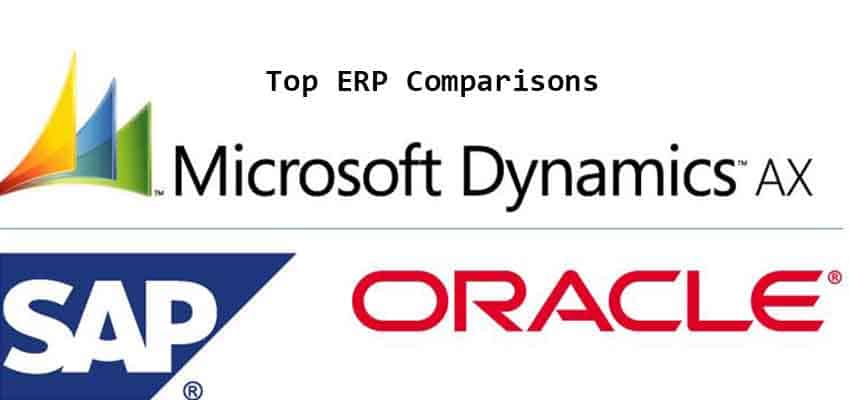Top ERP Comparisons SAP, Oracle & Microsoft Dynamics
- Blog September 04,2023

Nowadays, enterprises resource planning (ERP) is playing a significant role in the organizational management and all operational procedures. Today’s industries and preferring to adopt ERP applications that are capable of enhancing operational functionalities and accomplish business tasks within a centralized and integrated method.
ERP systems help to bring customer organization, human resources, financial managements, inventory control and supply chain capabilities under one platform. In past decade, SAP was the only ERP solution available for SMBs as well as large enterprises.
Industries use to relay on SAP for their tasks management but later on Oracle and Microsoft dynamics were introduced in the market. Introduction of these new ERP solutions revolutionized organizations managements a lot.
These three solution SAP, Oracle & Microsoft Dynamics have their own advantages as well as flaws. Before implementation of an ERP software solution for businesses, there is a strong need to evaluate the best compatible for you. These three ERP software solutions are implemented globally.

SAP, Oracle & Microsoft Dynamics Comparison
Here we’ve provided a detailed comparison of these three ERP giants from all perspectives including its deployment to implementation and cost.
SAP ERP
SAP ERP is a competitive enterprise resource planning software. It is developed by a German organization named as SAP SE. SAP ERP includes the main business functions of an organization. It is capable of handling a massive role in managing customer relations.
It has cloud based plus hybrid deployment possibilities features for customers. A leading ERP system that streamlines all of the business procedure across the industries. It is currently offering for 25 industries, 37 languages, and 45 localizations.
Module of SAP ERP:
Variety of business procedures are involved and handled by SAP ERP. Some of the significant SAP ERP modules are:
- Production Planning
- Quality Management
- Sale Management
- Financial Accounting
- Human Capital Management
- Real-Estate Management
- Payroll Management
- E-Recruiting
- Healthcare Management
- Supply Chain Management
- Business Warehouse
- Business Investment Management
- Extensive Customer Services
- Advance Planning & Optimization
- Human Resource Management
Along with these modules, Customer & Vendor Portal and employee portal is available as an external function of SAP ERP.
Inbuilt Integration Feature
There are various third-party integration tools are available for easy incorporation. It successfully integrates the functions from a wide range of industrial solution. It could also be re-integrated with the products of SAP business Suite that includes CRM, SCM, and SRM.
SAP ERP Deployment
All of the SAP ERP applications were developed on SAP Web Application Server. There were a lot of extension sets that used to deliver exciting features.
It efficiently contains all competencies of SAP Basis. SAP ERP has entirely changed the business architecture. It could be easily deployed for on-premise as well as a cloud based software solution.
Implementation
SAP ERP consists of multiple modules. It assembles and combine from all of its modules and offers enterprise resource planning.
During the implementation planning organizations pay attention to reviewing all implementation aspects. It secures them from implementation failure. Successful implementation streamlines all business procedures and diminishes data redundancy.
SAP ERP Deployment & Support Cost
SAP ERP deployment effectively reduce business costs including:
- Substantial Cost
- Labor Cost
- Administrative Cost
- Regulatory Compliance Cost
The implementation and support cost of SAP ERP software is higher because it takes a time period of around 12 to 30 month.
Oracle Applications
In the comparison SAP, Oracle & Microsoft Dynamics there is a time to discuss Oracle applications.
Introduction
Oracle applications encompass business as well as application software of Oracle Corporation.It delivers software’s for entire business e.g. HR, marketing, accounting, project administration, sales management, service transportation management and supply chain.
Initially in 1980s Oracle has launched an application suite with financial software. It sells different functional modules that use Oracle Relational database management system (RDBMS) as their backend.
Oracle Application Module
Oracle e-business suite, fusion application, people software enterprises & master data management are the significant applications owned by Oracle. Some of the application modules are enlisted below:
- Cash management
- Oracle Project Portfolio Management
- Payables
- Sales
- Customer Relationship Management
- Business Intelligence
- Advance Planning & Scheduling
- Landed Cost Management
- Process Manufacturing
- Payroll
- General Ledger
Along with all modules customer, vendor and self-service portal are the external functions.
Inbuilt Integration
Oracle application support an inbuilt integration function. There are various third-party integration tools are available for streamlined integration.
Deployment
Oracle application allows a smooth deployment whether for on-premise or cloud software solution.
Oracle Application Deployment and Support Cost
Oracle application deployments and support are higher. Its implementation is a time-consuming procedure that has increased its deployment cost. Oracle application customization is also costly.
Microsoft Dynamics
In SAP, Oracle & Microsoft Dynamics comparison it is a time to move on third ERP solution.
Introduction
In enterprise resource planning (ERP) Microsoft Dynamics is a line of business management software solution. These solutions are developed and owned by Microsoft. It has geared toward SMBs and larger enterprises. It owns five significant products that include:
- Microsoft Dynamics AX
- Microsoft Dynamics NAV
- Microsoft Dynamics GP
- Microsoft Dynamics C5
- Microsoft Dynamics SL
Microsoft Dynamics Modules
The major modules of Microsoft Dynamics are:
- Account Payable
- Cash & Bank Management
- Sales & Marketing
- Fixed Asset Management
- General Ledger
- Expense Management
- Product Information Management
- Warehouse Management
- Human Resource Management
- Service Management
- Payroll Management
- Retail Management
- Transportation Management
- Production Control
- Security & Administration Management
Besides these modules, Microsoft Dynamics also offers external functions that are employee portal, customer & vendor portal.
Inbuilt Integration
Microsoft Dynamics is offering several inbuilt integration application. Some of the frequently used inbuilt integration functions are:
- Office 365
- Microsoft Word
- Microsoft Excel
- Enterprise Portal for Dynamics AX
- Microsoft SQL Reporting Service Integration
- Microsoft Project Server Integration
- Application Integration Framework
Deployment
Microsoft Dynamics could be easily deployed for on-premise and cloud based software solutions. All of the deployment instructions are well-documented.
Microsoft Dynamics Deployment and Support Cost
If we discuss the Microsoft Dynamics implementation, it seems to be lower than SAP & Oracle Applications.
It’s deployment time is dependent on the business procedure and could be estimated for 6 to 15 month. There is need to hire external resources to provide customer support, therefore, its support cost is also low.
Final Thoughts
This price, implementation comparison along with short introduction is given to let the business select their own ERP solution. Picking the right ERP technology is an important step in driving business forward.
Suitable software implementation plays a huge role in success of business projects. These three giants of ERP, SAP, Oracle & Microsoft Dynamics can effectively support to revolutionized your business architecture.









 Saudi Arabia (English)
Saudi Arabia (English) United Kingdom
United Kingdom Global Site
Global Site